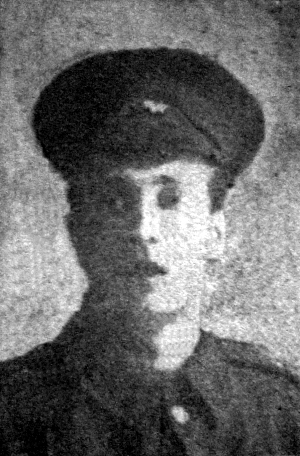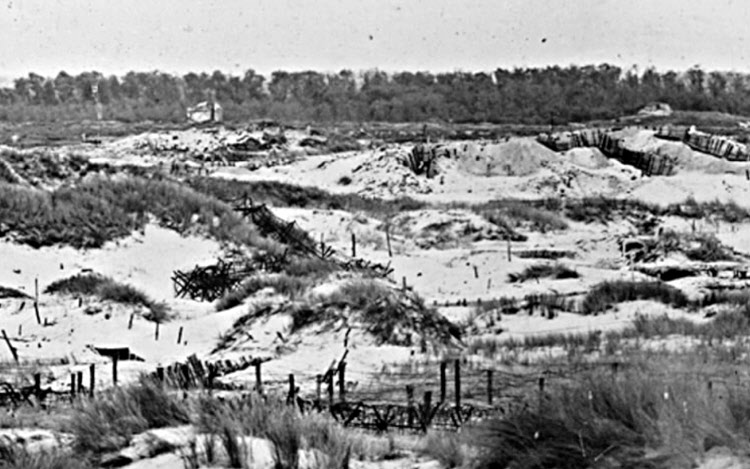
Herbert Jackson was born in Horbury, in August 1890, and baptised at Horbury St. Peter and St. Leonard Church on the 7th September 1890. He was the fourth child and first son of cloth miller, William Jackson and his wife Fanny (nee Hemingway), who married in the Wakefield area in late 1880. The couple had five children, all born in Horbury.
In 1891 and 1901 the Jackson family, including Herbert, were living in Horbury formerly at Carlton Street and then latterly at Club Houses. Herbert’s mother, Fanny, died in September 1910 and in 1911 William Jackson, widower was living with his three sons Herbert, Wilfred and John Jackson, still at the same abode at Club Houses, Horbury.
On the 27th April 1912, Herbert Jackson, aged 21, a dyer’s labourer, married 20 year old spinster Minnie Smith of Storrs Hill, Ossett at South Ossett Christ Church and they went to have two children. Sometime later Minnie Jackson and the children were living at Briggs Old Row, Storrs Hill, Ossett.
Herbert Jackson’s army service record has not survived, but it is known that he enlisted at Wakefield, and he was posthumously awarded the British and Victory medals, but he did not serve before the 31st December 1915 and consequently he was not eligible for the 1914/15 Star. His medal card records two service numbers of 4547 and 240599.
The 1st/5th Battalion of KOYLI was formed in August 1914 at Doncaster and was part of the 3rd West Riding Brigade, West Riding Division. They moved on mobilisation to Doncaster and then in November 1914 to Gainsborough. The battalion moved again to York in February 1915 for training and on the 12th April 1915, they landed at Boulogne. On the 15th May 1915 the formation became 148th Brigade, 49th (West Riding) Division. On the 2nd February 1918, they transferred to 187th Brigade in 62nd (2nd West Riding) Division and absorbed the 2/5th Battalion and were renamed the 5th Battalion.
On the 13th July 1917, two KOYLI battalions 1/4 and 1/5 marched from Annezin to Bethune station to entrain for Dunkerque, where they arrived in the course of the afternoon. They proceeded in barges to Zuydecoote (spending the night in the barges.) Next day, they marched to Bray Dunes, taking over some of the coast defences there. On the 18th July, a week after the 2nd Battalion KOYLI had experienced their hard fighting there, both KOYLI Territorial battalions (1/4 and 1/5) were in occupation of the Nieuport defences on the Belgian coast.
The 1/5th Battalion were in the front line with the 1/4th Battalion in support. The former had several casualties in its “A” and “C” Companies on the 18th July. On the 20th July, there was again a destructive artillery bombardment and the “1/4 KOYLI War Diary” records “Heavy intermittent shelling of Nieuport with 77mm, 10cm and 15cm H.E. fired from the direction of Westende and Middlekerke.” Private Herbert Jackson was killed by a German shell during this bombardment.
The “Ossett Observer” 1 had this obituary for Herbert Jackson:
“Another local soldier has made the supreme sacrifice in Private Herbert Jackson (27), of the King’s Own Yorkshire Light Infantry, a married man whose wife and two children reside at Briggs’ Old-row, Storrs-hill-road, South Ossett. The deceased soldier was brought up in Horbury, his parents living for many years at Club-houses, off Highfield-road, and the late Lance-corporal Willie Smith, of South Ossett, killed in action a few months ago, was his brother-in-law.
One of Private Jackson’s officers writing of his death, says that he was killed by shell fire on the night of the 19th-20th July, and was buried in a British soldiers’ cemetery along with other fallen comrades, just behind the line. The officer adds that the deceased had been with the company since Christmas, had been very capable and willing, and always a good lad. The officers, NCOs and men sent their deepest sympathy.
Though he joined the army over two years ago, it was not until the end of last year that he went to the front. He used to work for the Horbury Bridge Mill Company, and previously at the Crigglestone Colliery.”

Above: German positions on the dunes around Nieuport on the Belgian coast, between Ostend and Dunkirk, where heavy fighting took place in July 1917.
Private Herbert Jackson, aged 26 years, died on the 19th July 1917. He is buried at grave reference I. C. 21. at the Ramscappelle Road Military Cemetery, 2 Nieuwpoort, West-Vlaanderen, Belgium. Ramscappelle Road Military Cemetery is located 2 Kms east of Nieuwpoort on the N367, which leads from Nieuwpoort to Sint Joris.
From June to November 1917, Commonwealth Forces (XV Corps) held the front line in Belgium from St. Georges (now Sint Joris), near Ramscappelle, to the sea.
Most of Plot I of Ramscappelle Road Military Cemetery was made in July and August 1917, but the cemetery was considerably enlarged after the Armistice when graves were brought in from the battlefields and the following smaller burial grounds:-
Boitshoucke Churchyard, where three men of the R.G.A. were buried in July and August, 1917.
Ghistelles German Cemetery, on the road to Hagebrugge, where four airmen were buried by the enemy in 1917 and 1918 and two by their comrades in October, 1918.
Middelkerke German Cemetery, on the coast road to Ostende, where twelve Canadian and ten United Kingdom soldiers were buried in 1915-1917.
Nieuport Military Cemetery, on the South side of the town, a French cemetery in which 107 British soldiers and one sailor were buried. It was closed in July, 1917 as excessively dangerous.
Nieuport-Bains Military Cemeteries No.1, No.2 and No.3, Oost-Dunkerke, French cemeteries close together at the West end of Nieuport-Bains. No.1 contained one British grave of 1917, No.2 two of 1918, and No.3 91 (including two Australian) of 1916-17.
There are now 841 Commonwealth casualties of the First World War buried or commemorated in this cemetery. 312 of the burials are unidentified, but special memorials commemorate two casualties known or believed to be buried among them. Also within this number are 26 special memorials to casualties originally buried at Nieuport or Nieuport-Bains whose graves were destroyed by shell fire.
There are an additional 2 unidentified Foreign National burials here.
References:
1. “Ossett Observer”, 4th August 1917